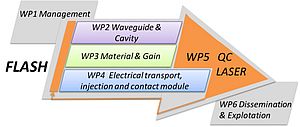The project has been split into six workpackages (WPs) namely:
- Management
- Waveguides and Cavities
- Material Gain and Nonlinearity
- Electrical transport and contact modules
- Electrically pumped QCL
- Dissemination and Exploitation
The overall approach is to break up the work to produce a laser into the minimising of the losses of the waveguide (WP2), the optimisation of quantum well (QW) structures for gain (WP3) and the optimisation of the electrical transport and in particular the injection of carriers into the upper laser state and the depopulation of carriers from the lower laser state (WP4). Finally the outcomes of all these optimisation steps will be pulled together in WP5 to produce a working QCL, first at any temperature and with any power before optimising to aim for 1 mW at 300 K.
A strong feature of FLASH is the use of silicon substrates and group-IV semiconductor heterostructures, instead of GaAs or InP wafers & group III-V heterostructures presently used in existing QCLs. This important difference must not be underestimated from both the technology & physics points of view. Therefore, while WP3 will develop the final heterostructure material with the correct quantum design developed during the course of the project, WP2 & WP4 will start immediately from M01 to work on template epitaxial material featuring technology-related (electrical injection, cavity fabrication process, etc.) and physical characteristics (thermal conductivity, effective refractive index, crystal defect density, etc.) very similar to those of the envisaged final optimized laser heterostructure. This innovative strategy will allow us to solve most technology-related problems separately from the quantum experiments & design, while ensuring a continuous feedback among the WPs because all partners participate in both types of activities. This clearly will help the FLASH team to achieve its demanding targets within the proposed timeframe and would offer several solutions for risk-mitigation.
